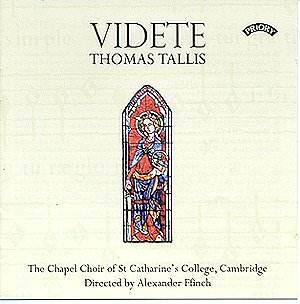One of the striking musical happenings of the last
twenty years is the number of very good vocal groups/choirs which have
come into being, many of these being either young undergraduates or
recent graduands. This is even more noteworthy when one considers the
decline in music in our schools and churches. St. Catherine’s College
is a case in point. They are very good as a young choir with an almost
equally young director of music.
There is much to admire here, but also some rather
disturbing faults. The choir relies on contraltos rather than counter-tenors
(there is one only). This may be from necessity but is against current
practice and thinking. I find it odd, given the recent popularity of
the male alto voice and it certainly affects the timbre of the performances.
Having said this the tone of the choir is good, both the sopranos and
basses being firm and accurate in pitch. The bass tone is particularly
noticeable and welcome. This is maybe even a little too much forward,
but this serves to give even more definite character to a piece. That
very character is heard to advantage in the opening Salvator mundi,
Domine. It may be that one gets more used to the sound thereafter as
I was not so conscious of it later on. The singers of the inner parts
are also sure of their contributions, but not so noticeable.
In performance, the plainchant singing is exemplary
and a pleasure to hear. Again a feature of modern choirs is excellence
in this type of music. However, some entries are weak in the main body
of pieces and lack attack. This then affects other entries in the same
passage. The ensemble is generally well blended, speeds are nicely judged
and the balance is good. The factors above prevent me giving the disc
a whole-hearted welcome, even more so as it is at full price. It must
be remembered that the performers are up against very stiff opposition
at this level. String competition comes mostly from the Cardinall’s
Musick on Signum, not to mention the Tallis Scholars, The Sixteen and
other high class professional choirs. At budget price, the Oxford Camerata
on Naxos are at least as good and are excellent value.
The booklet, alas, could be more informative; Latin
and English translations are given, but the number of singers is not,
except in a few cases after a search of the text. We are told nothing
about the choir except the names. The history of its foundation together
with details of performances and concerts are left unknown. The director,
Alexander Ffinch, receives the briefest of mentions at the end of the
booklet.
John Portwood
